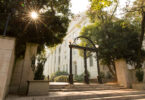With startling growth rates in the 16-county metro Atlanta area, there is a loss of 54 acres of trees and a gain of 28 acres of hard surface daily.
How this compares to other cities in the Southeast is unknown, but that is about to change. Elizabeth Kramer, public service assistant for the Institute of Ecology and the director of the Natural Resources Spatial Analysis Laboratory, will create data sets showing changes in land covered by trees and other vegetation, or tree canopy, throughout urban areas in the Southeast.
“When we lose tree canopy, we lose a number of important and ecological and economic services,” said Kramer, whose research is being funded in part by the U.S. Department of Agriculture.
“Trees help protect air and water quality and maintain biodiversity. In addition, when we remove trees, we lose the natural capabilities for moderating temperatures, resulting in higher cooling and heating bills,” she said.
Furthermore, research has shown that in Athens, for example, a large tree planted in front of a home adds almost 1 percent to the sale price. And cutting trees down to build subdivisions does not necessarily increase the value.
“Yes, if you put houses on a piece of land instead of trees, you will get new revenues,” said Jeffrey Dorfman, co-director of the Land Use Studies Initiative at UGA. “But you also will have new expenditures. You will need roads, schools, libraries, trash collection, water and sewer services. It turns out, it’s usually going to cost you more than you bring in.”
Kramer said the Athens sample proved to be helpful and cost efficient, fueling the drive for bigger projects.
“Creating a data set for the Southeast will create a prototype that can be extended to the entire continental U.S., which would help evaluate the success of green space plans,” she said.
The data sets will be available online in a user-friendly format so that information can reach a broad audience.
“In the short term, we hope to be able to compare development patterns of urban areas across the southeastern U.S. with one another,” Kramer said. “Also, we will create materials to train urban foresters, local government staff and nongovernmental organizations to use this information for tree ordinance development, watershed planning and other applications.”




